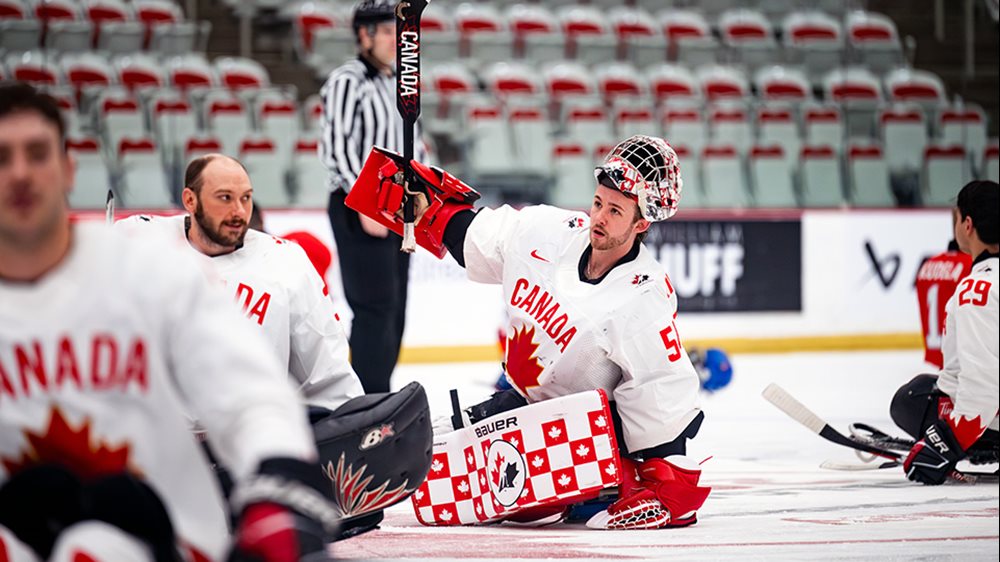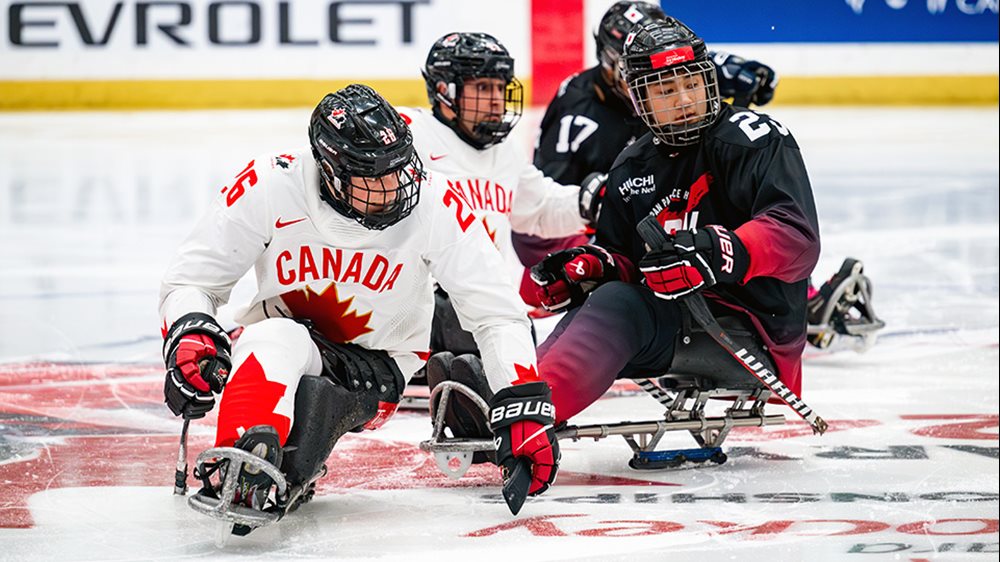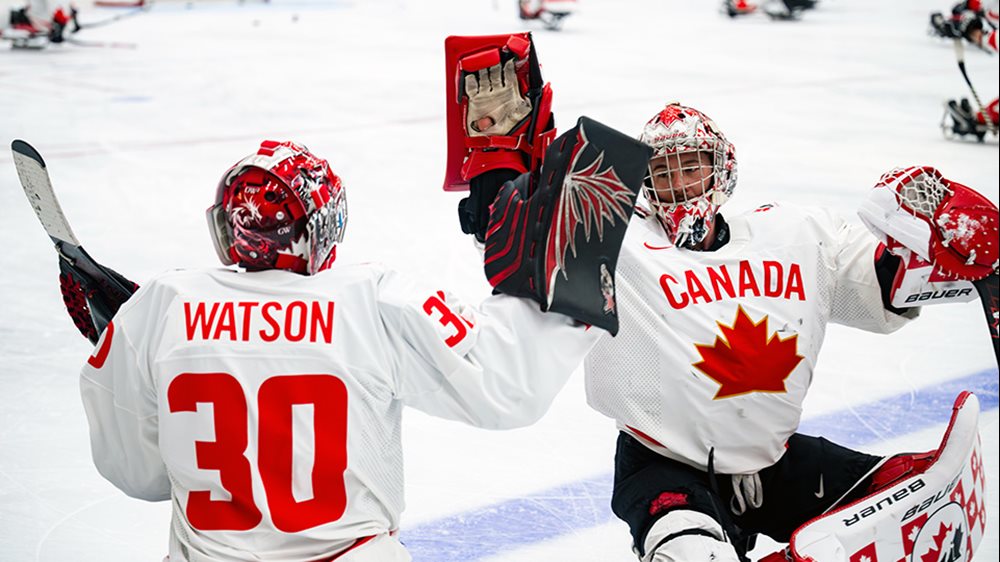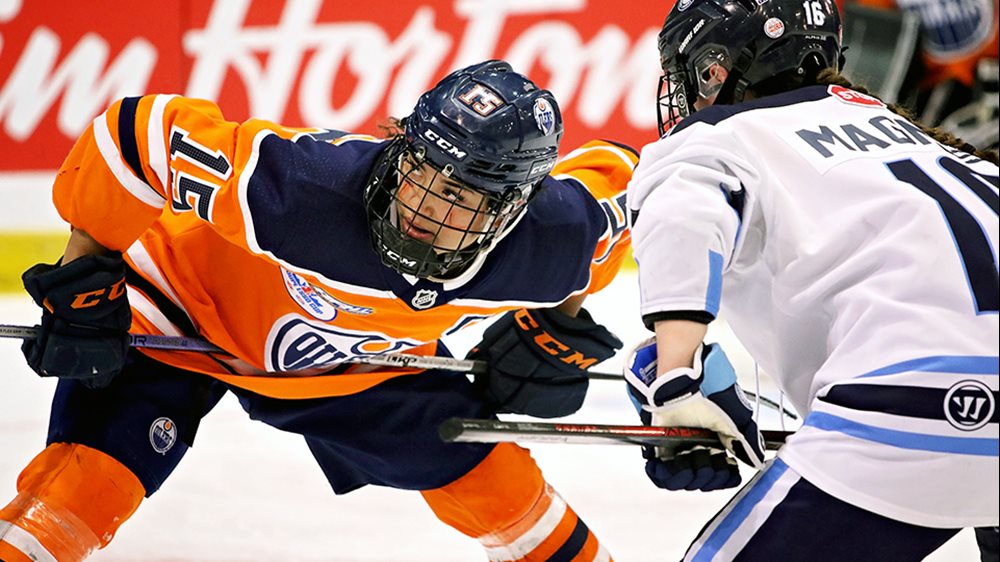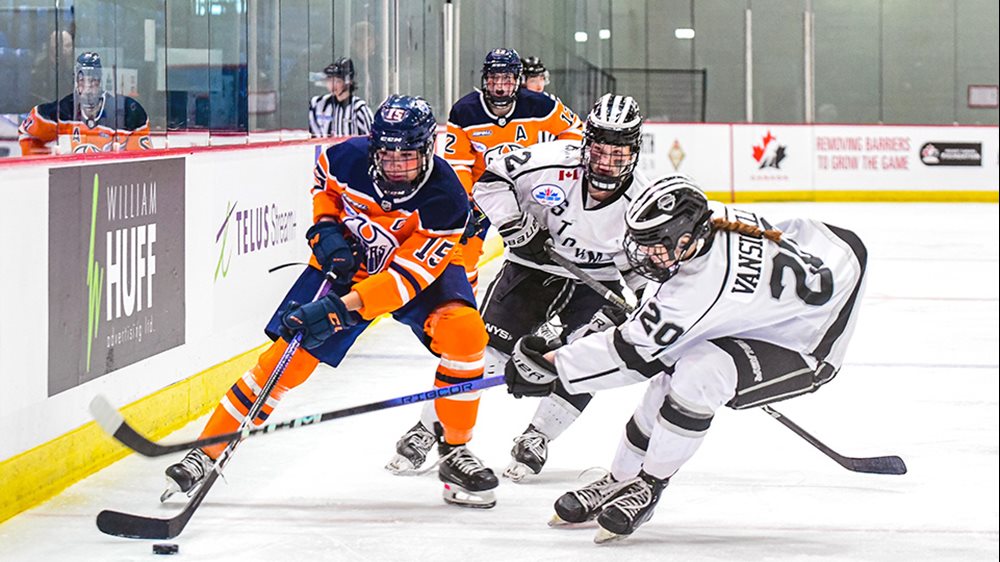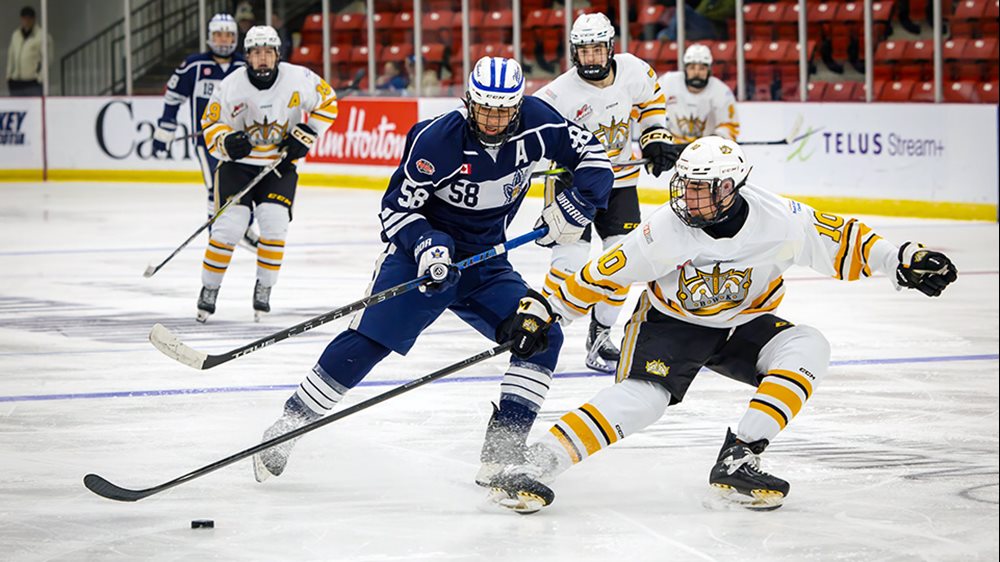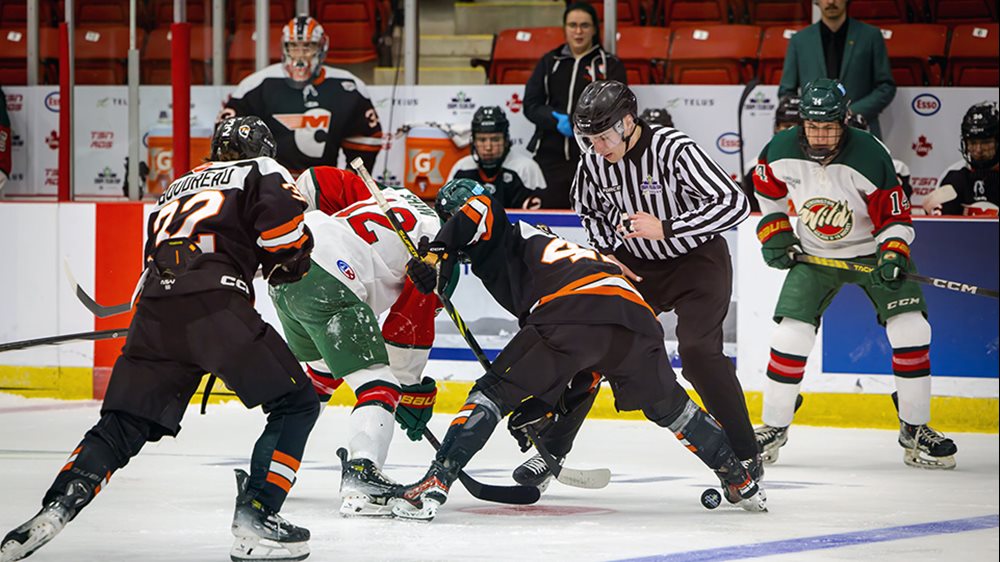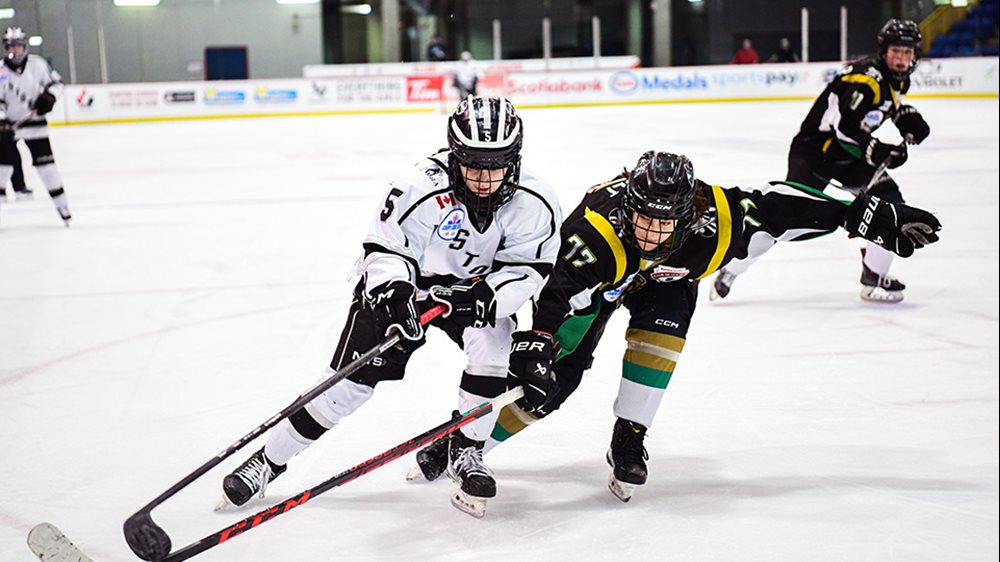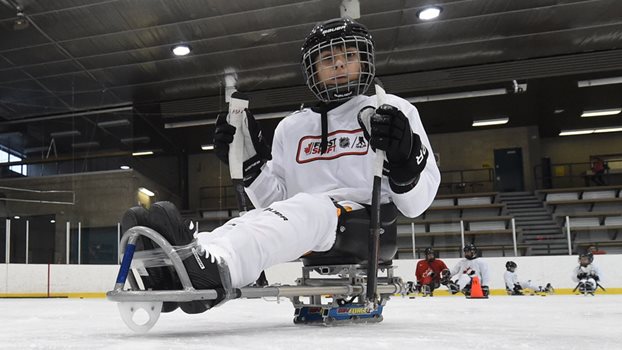
First Shift sparks interest in para hockey
With an accessible and affordable way to try the sport, the NHL/NHLPA program is helping to introduce young players to para hockey and inspire Paralympic dreams
With the NHL/NHLPA First Shift successfully offering a low-cost entry into hockey for families new to the sport, Maxime Gagnon saw an opportunity to expand the program by offering para hockey.
Along with Parahockey Montréal, Gagnon helped to run the program’s first para-specific event in 2018.
“When we started the program four years ago, we started with 15 new players. That’s amazing in para hockey,” says Gagnon, who is the CEO of Parahockey Montréal. “Normally, we receive [across] all divisions about 10 players, not more than that. But for only junior, 15 players, that’s amazing.”
Gagnon is currently hosting the third edition of the NHL/NHLPA First Shift para program in Montreal. One new addition this year was the para program and a First Shift for stand-up hockey had its Bauer equipment fittings back-to-back, which helped to drive home the message that every participant is partaking in the same program.
“The inclusion for me is very important,” Gagnon says. “We’re going to do probably one or two practices all together on the ice, the stand-up and the [para] hockey program.”
Along with equipment, participants will have six on-ice sessions to learn the basics of the game and have fun with their peers. Instructors will help to teach and mentor participants, something Paralympic Hockey Team forward Anton Jacobs-Webb found very important when he started playing para hockey.
Jacobs-Webb looked to veteran para hockey players like Hervé Lord and Ben Delaney to help teach him how to stick-handle and have control of his sled when he was starting out.
“That’s the biggest thing for me is having people mentor you and to show you the little tricks and little tips because there’s so many [skills to develop] to get into [para hockey] because there’s such a steep learning curve right at the beginning,” Jacobs-Webb says.
The timing of this season’s program also aligns with the 2022 Paralympic Winter Games in Beijing, which allows the young participants to see the sport on an international stage while they are trying it for themselves at home. Gagnon is planning to work the Paralympics into the NHL/NHLPA First Shift program, including filming a video to send good-luck messages to Canada’s Paralympic Hockey Team.
Overall, with the combination of the NHL/NHLPA First Shift para program and the exposure of the sport’s top athletes competing in Beijing, the goal is to help spur the dreams of young athletes in para hockey.
“The more accessible it is, the more people will try it. And just more importantly, know it exists,” says Greg Westlake, a veteran forward on Canada’s Paralympic Hockey Team.
“I heard about this sport at the age of 14 years old. I wish I heard about it when I was five. I think that the efforts that we’re doing right now, through programs like [NHL/NHLPA First Shift], that’s what’s going to make the difference for the next little kid born with a disability that can get out there and get in a sled at five years old and really start that [Paralympic] dream so much earlier.”
Thanks to the NHL/NHLPA First Shift, there is an accessible, affordable, safe and fun way to introduce kids to the sport of para hockey across Canada. Gagnon has already seen the benefits of the para program in terms of the retention and growth of the sport at the grassroots in Montreal.
“Next year, we’re going to have the kids who started four years ago with the [NHL/NHLPA First Shift] and they’re going to be invited to the provincial selection for [para hockey] in Quebec,” Gagnon says. “For us, it’s very important. The wheels are turning. The more kids we have, the more players we’re going to bring to the national team or represent our province.”

Leading the growth of para hockey
As a veteran Canadian para hockey player, Dr. Peggy Assinck’s goal is to grow the sport internationally and ensure women have a chance to play the game she loves
Growing up, Dr. Peggy Assinck was very athletic. She was not yet identified as being born with spina bifida—a congenital defect of the spine—so she was entirely able-bodied and played a variety of sports.
That’s why when she experienced complications from her condition and became paralyzed from the waist down at age 11, she felt like she lost a bit of her identity.
“It was really difficult to be honest with you, because I think I really self-identified as an athlete,” Assinck, 38, says. “My parents really wanted to find a way to have me be involved in sport, despite the fact that I was dealing with ongoing medical and paralysis-below-my-waist issues.”
A recreational therapist recommended she try one of the only adaptive sports near Peterborough, Ont., at that time: para hockey. Assinck and her family travelled 90 minutes away from home to try the sport for the first time. Although it wasn’t necessarily love at first skate, she was thrilled to meet other kids just like her.
“Because I grew up in such a remote community, I'd never met anyone else in a wheelchair or anyone else using adaptive equipment,” she says. “That was pretty cool just to meet other disabled kids.”
With time, her passion for para hockey grew and flourished. Now one of the veterans with Canada’s national women’s para hockey team, Assinck’s goal is to ensure other women and girls around the world have an opportunity to try the sport she has dedicated her life to.
Ensuring positive experiences for women
One thing Assinck emphasizes is ensuring positive experiences for women when they try para hockey for the first time. As the women’s team holds its selection camp in Yellowknife, N.W.T., from April 25-30, a grant from the Hockey Canada Foundation will assist with providing try-it opportunities and grassroots sessions in the community.
“I want to make sure that more kids and more people who sustained new injuries are getting a good first-contact experience,” Assinck says. “I think the Hockey Canada Foundation grant really helps for the women’s para hockey team to do that in remote communities [and] to help support female-specific programming.”
We believe as a Foundation that girls grow when they play hockey and hockey grows when girls play,” says Alexandra Wise of the Hockey Canada Foundation.
“Working with an organization like Women’s Para Hockey of Canada is something that allows us to align our missions and keep developing the game from a grassroots level, but then also at a higher level," Wise adds.
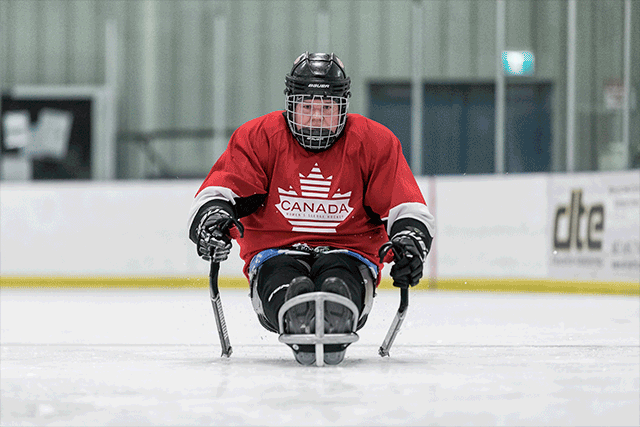 It’s no coincidence that wherever Assinck has gone in her life, women’s
para hockey has grown with her guidance and support. Inspired by wanting to
learn more about spina bifida, she attended Brock University to pursue a
neuroscience degree. As she completed her undergraduate degree, she played
with the Niagara Thunderbirds and volunteered with the Brock Niagara
Penguins, a sporting program for youth and young adults with a physical
disability.
It’s no coincidence that wherever Assinck has gone in her life, women’s
para hockey has grown with her guidance and support. Inspired by wanting to
learn more about spina bifida, she attended Brock University to pursue a
neuroscience degree. As she completed her undergraduate degree, she played
with the Niagara Thunderbirds and volunteered with the Brock Niagara
Penguins, a sporting program for youth and young adults with a physical
disability.
Upon her graduation in 2008, Assinck began her master’s degree and completed her PhD in neuroscience at the University of British Columbia. Looking to continue training as an elite para hockey athlete, she searched for a club team to join in her new home province.
“After growing up in southern Ontario, where para ice hockey was everywhere, I was quite surprised at how little para ice hockey was in British Columbia as a whole,” she says.
Once she joined a team based out of Surrey run by SportAbility, Assinck helped to create new para hockey programs in Vancouver and Victoria, and aided in making opportunities across the province to try the sport. From there, she helped to organize a provincial team with support from BC Hockey.
Traveling across the pond
A postdoctoral fellowship took Assinck overseas in 2017 to the University of Edinburgh and the University of Cambridge. There were a handful of club programs in Great Britain when she moved, and the Canadian quickly joined the closest team to her—the Manchester Mayhem—to continue training.
“I’ve been participating as an athlete on that club team for a while, but I think it became pretty clear that I had a lot of expertise in para hockey, and I got asked about a year into playing here to join as the assistant coach on [Great Britain’s] men’s para ice hockey team,” she says.
Assinck traveled with Team Great Britain to the IPC World Para Hockey Championship, B Pool, in 2019 in Germany.
“I think I was probably the only athlete who was also a coach, I was probably the only female who was also a coach,” she says. “It was a really amazing opportunity to just be on the bench and to help to support the men’s program in what they were doing and in their goals.”
With the addition of coaching on her résumé, a new opportunity presented itself in 2021: the International Paralympic Committee approached the coaches of Great Britain’s men’s para hockey team to ask if they would create a women’s team.
I suddenly found myself with the opportunity to create a team in another country… and it just seemed like the right space for me,” Assinck says.
Assinck quickly got to work. She put out a call for athletes with lower-body disabilities living in Great Britain, interviewed potential players and selected 27 athletes —most of whom had never played para hockey before—for the new program.
Although Assinck was leading the charge overseas, she continued to receive support from Team Canada staff back home. One of the difficulties she encountered was a lack of ice time, meaning she was often teaching a group of athletes how to play hockey without being on the ice.
“She’s spending time in classrooms teaching them the basics of hockey,” says Tara Chisholm, head coach of Canada’s national women’s para hockey team. “She’s renting out gymnasiums so they can do floor hockey and learn about systems that way. She’s literally pulling everything she can together to teach these athletes how to be hockey players in a space that really is not intended to flourish for hockey players.”
Despite the limited resources and the challenges of creating a new team during the COVID-19 pandemic, the newly formed Great Britain national women’s team is prepped to compete at its first international event, the IPC Women’s World Challenge, this fall.
“I honestly do not know how she does everything that she does,” Chisholm says. “I’m very grateful for all the work that she has done that goes unnoticed and that has essentially helped to develop women’s para hockey to where it is right now.”
Growing the game in Canada and beyond
As she created the team, Assinck put together a document of how she kickstarted the program with the goal to share it with other countries so they can replicate the processes.
“That is the big goal right now, to not only grow the game within our borders of Canada, but then to make sure that other girls and women with disabilities across the world have the opportunity to play the sport of hockey,” Chisholm says.
“In order to be in the Paralympics, we need more countries to create teams,” Assinck adds. “We just want to make sure that they have a great first experience and that we’re creating a sustainable program that can continue for many, many years.”
I’m a true believer that if I hadn’t been involved in [para hockey] when I was young, when I was going through the struggles that I had, I wouldn’t be the person I am today,” Assinck says.
Although it’s a bit of an odd position to play against the team you created in competition, Assinck had the full support of her British colleagues to return to Canada and prepare for the Women’s World Challenge. Despite everything she has done to grow the sport, she still prioritizes being the best athlete she can be and she trains hard to earn the privilege of wearing the Maple Leaf on her chest.
She hopes people see her as someone who has dedicated a lot of her life and finances to being an elite athlete, and someone who has gone over and above to support women and para hockey in Canada and around the world. It’s the least she could do for a sport that has changed her life.
“I’m a true believer that if I hadn’t been involved in [para hockey] when I was young, when I was going through the struggles that I had, I wouldn’t be the person I am today,” she says. “I wouldn’t have the confidence to be up speaking in front of thousands of people about neuroscience or even the confidence to be able to be jumping around from team to team in some of my coaching roles.
“I’m hoping that I can look back and feel like I did everything I possibly could to make sure that people with disabilities, particularly women with disabilities, are getting exposure to the sport that means so much to me and could mean so much to them.”


Inspiring the next generation through First Shift
Central York Girls Hockey Association players assisting with the NHL/NHLPA program are excited to share their passion for hockey with young participants
When Kennedy Jackson started playing hockey when she was four years old, she was inspired by current players who took time to volunteer with her team.
“I always looked up to older girls that were helping me out on the ice,” she says.
Now 17, Jackson has an opportunity to give back as an NHL/NHLPA First Shift coach for an all-girls program with the Central York Girls HockeyAssociation (CYGHA).
“I just want them to be able to feel the way that I did,” says Jackson, who plays for CYGHA’s U18 A Blue team. “I just want to be able to help other kids love the game of hockey kind of like the way I did growing up.”
The return of the program has been highly anticipated for the Aurora, Ont., association. The CYGHA hosted its first NHL/NHLPA First Shift program during the 2019-20 season, but the COVID-19 pandemic has prevented it from returning until now.
“I’m just really excited because we’ve had this program cancelled for a couple of years,” says Keith Higgins, CYGHA’s on-ice coordinator for the NHL/NHLPA First Shift program. “I had such a good time, so much fun the first time around.”
CYGHA’s all-girls NHL/NHLPA First Shift program begins on March 26 with an equipment try-on session where all participants will be fitted with a full set of new Bauer equipment. Afterwards, the participants have six on-ice sessions to learn the fundamentals of skating and hockey skills.
“It is really cool to see that one kid that on the very first session, all they do is stand there and kind of swivel on one spot. And you get a couple of weeks into it and the kid’s skating the full ice and making some motion and hitting the puck,” Higgins says. “It’s really neat to see the progression, the kids pick it up so quick.”
With the combination of receiving equipment and being on the ice, the NHL/NHLPA First Shift program serves as an accessible and affordable entryway into hockey.
“It’s a great way to recruit new members,” says Katie Williams, vice-president of CYGHA’s women’s division. “The girls have a fabulous time; our volunteers are just terrific. They enjoy it as much as the kids. It’s just a great way to showcase girls’ hockey in our community.”
“I think, in general, we really need to be cognizant about keeping the girls in the game and keeping it accessible and affordable,” says CYGHA president Mark Dubeau. “We’re always having somebody there from our executive [team] to talk to parents while the kids are out on the ice and […] hopefully get them into a position where they love the game and want to continue with it.”
With Canada’s Women’s Olympic Team taking home gold at the 2022 Olympic Winter Games in Beijing, the increased visibility of the women’s game on an international stage may also encourage more young girls to lace up the skates and pick up a stick.
“I think that seeing the women win the gold medal this year in the Olympics, you can inspire little girls and little kids to want to play the sport and learn about it,” says Katie Macey, a 16-year-old member of CYGHA’s U18 A Blue team. “Just seeing other women achieve their goals in hockey might inspire other kids to want to do that.”
Team Canada is not the only source of inspiration to get young girls on the ice. Many volunteers for this NHL/NHLPA First Shift program are current CYGHA players from U13 to U18, allowing participants the opportunity to build connections with young role models in their hockey community.
“It means a lot,” says Macey, who will volunteer as a coach during the First Shift. “Being a role model, you set good examples, teach them how to respect, teach them how to work hard, teach them skills—it’s a lot of responsibility.”
Higgins’ daughter, Kaia, was a volunteer with the program during the 2019-20 season. This year, the 12-year-old will be a junior coach and is looking forward to assisting participants during the on-ice sessions.
“It feels really good knowing that [I can be a role model],” she says. “When I was younger, I always wanted to grow up and continue playing hockey and have younger girls look up to me.”
At the end of the day, the volunteers are excited to share their love of the game with the next generation of young players.
“I just wanted to help little kids find passion in hockey, that’s where I feel the most comfortable,” Macey says. “Whenever you step on the ice, it’s always like [you] forget about everything else and I just want to help little girls find that same passion in the sport that I love.”

Sharing the passion
As one of the few Black players in her league, Willa Evans is excited to share her love of hockey with youth in Nova Scotia’s first NHL/NHLPA First Shift BIPOC program
As a young Black player growing up in Truro, N.S., Willa Evans struggled to find other youth that looked like her when she first got involved in the game.
“Growing up, my classmates were never like me. My teammates were never like me, and my coaches were never like me in that sense, being Black,” the 17-year-old says.
Now captain of her U18 AA team and the first Black captain of the Fundy Highland Female Hockey Association, she finds time to travel one hour each week to volunteer with Hockey Nova Scotia’s Black Youth Ice Hockey Program as a junior instructor. When she heard the province would be hosting its first BIPOC session as part of the NHL/NHLPA First Shift program, Evans jumped at the opportunity to volunteer.
“I’m really glad that the youth now have a chance to participate with people that are like them,” she says. “All the opportunities that these young kids have is very exciting for me to watch… with all of the different ways that they can get together and help the young youth get better together as the Black community.”
Evans wasn’t the only one who wanted to be involved with this program. There was an “overwhelming response” of volunteers, according to Dean Smith.
“I think it’s amazing,” says Smith, who is the chair of Hockey Nova Scotia’s Diversity and Inclusion Task Force. “The more people who are enrolled, the more members of the BIPOC community in dressing rooms, on the ice, in the officiating ranks, in the coaching ranks… it makes a huge difference. It’s role models for them to live up to.”
Along with the influx of volunteers, there’s also been lots of positive feedback from local hockey associations in the province, including requests to host their own NHL/NHLPA First Shift BIPOC program.
“We’ve had some comments about players wanting to play with kids that look like them, and that’s what these opportunities really do,” says Brad Taylor, technical director for Hockey Nova Scotia. “It’s the ‘see it is to believe it,’ really, so it’s great we’re able to do that and make that education and awareness piece within our ranks.”
“Every child, regardless of race [or] economic background, should have an opportunity to play [hockey] and love and enjoy, and that’s what we’re trying to create for these kids,” Smith adds.
Although it is a six-week program, the goal is for the hockey journey of the 30 participants to continue. Taylor says Hockey Nova Scotia is ready to support each participant and encourage them to sign up for minor hockey in the fall.
“It’s so important for these kids to continue to play,” he says. “Our goal would be to make sure we make it an easy transition.”
With dreams of becoming a coach and a teacher when she’s older, Evans is excited to get to know each of the young participants in the program.
“I want to teach young kids, so I love getting the experience of working with children,” she says. “I love their mentality. They’re always like ‘Yeah, I can do it,’ and it honestly makes me feel more confident being their coach and hearing them say that they can do it.”
National Women’s Team forward Sarah Nurse, who is on the ice in Beijing at her second Olympics, has been an inspiration to Evans throughout her hockey career. As a volunteer, she’s looking forward to the possibility of inspiring the lives of the program’s participants.
“To be one of those young kids’ role models… I don’t even know how to describe it. I’m just wowed by the fact that I’m old enough to be a role model,” she says. “I’m just absolutely excited to start working with these young kids.”
Over their six sessions together, Evans will have the opportunity to help develop the young participants as hockey players. But if there is one thing she hopes they will learn from the program, it’s her passion for the game.
“I just hope that they take from me the love of hockey and the amazing experiences they will get with hockey, and just them not giving up because times are hard,” she says.
“With us getting a whole bunch of opportunities for these young kids, I feel like they will want to help out when they’re older with their kids… I feel as if we are growing as the Black community in Nova Scotia and I feel like this is making us very much stronger.”

Remembering your roots
National Para Hockey forward James Dunn has become a role model in his home community as a guest coach and public speaker
The Hockey Canada jersey had been in Alexander Tait’s bag for too long. It needed to be washed – badly. But the eight-year-old was really worried.
The jersey had James Dunn’s signature on it and Alexander couldn’t lose that.
“I think he’s like Terry Fox and he’s a Canadian hero.”
Though Dunn may balk at the comparison, Alexander’s father and Dunn’s former high school teacher, Rob Tait, said for the small communities of Elgin County in southwestern Ontario, where Dunn grew up, it is absolutely true.
“James is just a very special person, and his story is a great one for young and old to follow along with,” says the elder Tait.
Dunn was diagnosed with osteosarcoma and had his right leg amputated at just 12 years old in 2012. It was the same cancer that also cost Terry Fox his leg and life.
The same year as his surgery, Dunn was introduced to para hockey with the London Blizzard Sledge Hockey Club. Four years later, he was a silver medallist with Team Ontario at the Canadian Sledge Hockey Championship. And by 2018, Dunn was in PyeongChang, South Korea, for the Paralympic Winter Games. He was the youngest player in Hockey Canada history to represent the red and white at the Paralympics.
“I would think the majority of people, if they encountered what he had to go through, they would have been very negative,” Rob says. “But I don’t ever remember James wanting to have a pity party or anything like that.
“He just said, ‘No, I’m going to beat this,’ and he did.”
Rob said the entire community cheered for Dunn as he beat off the disease. Then they cheered as he suited up for Team Canada and became a local hero. But never has that support changed Dunn as a person. If he is in town, he’s always willing to come out for a practice with a local team or speak at a community event.
“I really just like to see the passion the kids have for the game,” Dunn says. “When I was that age, I loved the game and just to see them having fun out there and enjoying it is the biggest thing for me.”
One of Dunn’s fondest hockey memories comes from hockey class at West Elgin Secondary School. It was his turn to plan a practice, so he brought out sleds for the whole class and taught everyone to play para hockey, even Rob.
“It’s really cool to see people try para hockey for the first time and to experience the sport I play,” Dunn says, smiling at the memory. Rob, meanwhile, laughs outright thinking of his time in a sled.
“I gained a lot more appreciation for [para hockey],” Rob says. “Some of the kids did alright but I got set up at the hashmarks and couldn’t get out [of the zone].”
Since graduation and his rise to the national team, Dunn has returned to Tait’s hockey class as a guest coach, with the students in awe of his abilities and poise. Tait said he has to remind his class that Dunn is only a few years older and very happy to answer questions. But the real magic, Rob says, will happen anytime Dunn comes out for a practice with a minor team.
“Here you have these eight- and nine-year-olds and usually it’s like herding cats, but James came out on the ice and I blew the whistle and they were quiet as church mice,” Rob says. “The kids don’t see him as having a prosthetic, he is a Team Canada athlete.”
Which is also what Alexander wants to be one day, like his hero James Dunn.
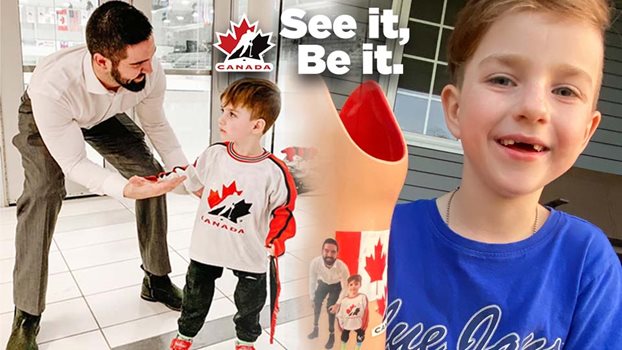
Timing is everything
How a chance encounter with Greg Westlake eased the transition to a life with prosthetics for Maddux Kerr
Jessica Kerr was more than a little overwhelmed when prosthetist Amy Richardson walked into the patient room at Holland Bloorview Kids Rehabilitiation Hospital. Her 13-month-old son, Maddux, had just tried on his new legs for the first time and Jessica was still coming to terms with the changes to her family.
Richardson said someone wanted to meet Maddux, because his new prosthetic legs reminded the stranger of his own. Greg Westlake walked in, sat down and talked to Jessica, Maddux and the whole Kerr family.
Six years later, they’re still talking.
“It totally changed our lives that day,” Jessica says of the chance encounter with the National Para Hockey Team veteran. “It was, to that point, the most emotional moment we’ve had with Maddux because we were thinking, ‘What can he do now?’”
But Westlake gave them the answer they needed to hear: everything, Maddux can do everything. And from that point on, Westlake had a lifelong fan.
Maddux was born with fibular hemimelia and required a double-leg amputation when he was 11 months old.
“I don’t have all the answers for all the disabilities out there, but I can sure talk to the leg amputees; that’s something I know a lot about,” Westlake says with a smile. It’s something his family knows a lot about, too.
After the initial meeting with the Kerr family, Westlake introduced Jessica to his own mother, Deb, and the two became fast friends. Jessica still uses Deb as a resource to navigate new milestones in Maddux’s life.
“I remember when Maddux was first going to school and I was like, ‘Ok, you need to tell me everything I need to tell [the school] or ask them for when he goes to school,’” Jessica says. “It’s just been so amazing to have that connection with [the Westlake family].”
With three Paralympic medals and eight world championship medals, Westlake is a recognizable role model for young para-athletes. But he considers his advocacy work in more general terms, just trying to ensure those with disabilities are given the same opportunities their able-bodied peers are.
“I think it’s important for [para-athletes] to be out in the community and that goes all the way back to the ‘If you see it, you can be it’ mentality,” Westlake says. “I remember being a little kid myself and from the time I was three I learned to skate on two artificial legs, and I’ve always loved the game.
“But I never saw anybody on TV who looked like me.”
While Westlake works to increase that exposure for his sport and the general needs for people with disabilities, his regular presence with the Kerr family remains integral to Maddux’s understanding of his own life. Especially when he starts asking Jessica some really hard questions.
“Maddux has said different times, ‘When do I get my real legs like you?’ and we can say, ‘Look at Greg, does he have legs like ours?’” Jessica explains. “So that’s what your legs will be like, buddy, and look at everything Greg can do.”
It’s a message Maddux has taken to heart and also to his leg. His current prosthetics feature a photo of Maddux with his hero.
“Greg is my friend,” Maddux adds with a smile.

NHL/NHLPA First Shift, by the numbers
A fact-and-figures look at the NHL/NHLPA First Shift, on and off the ice
The return of our game means the return of the NHL/NHLPA First Shift. The eighth season of the program kicks off Wednesday in St. Catharines, Ont., and Hockey Canada, Bauer, the NHL and the NHLPA are excited to help more kids fall in love with hockey.
The NHL/NHLPA First Shift program is designed to facilitate entry into hockey by offering a program that is accessible, affordable, safe and, most importantly, fun! Each program includes a full set of Bauer equipment properly fitted by experts, a welcome event and six on-ice sessions with fun drills and great instructors.
This unique program is designed to ensure a positive experience for any families that are new to the game. We want families to experience the game at its best and provide a memorable and fun event to our participants.
As we head into our eighth season, here’s a look at NHL/NHLPA First Shift, by the numbers.
4: Para hockey programs scheduled for the 2021-22 season. Since 2014, we have run four para hockey First Shift events, meaning that by the end of the 2021-22 season we will double the number of executed para hockey programs.
6: On-ice sessions included in every NHL/NHLPA First Shift program. Each on-ice session focuses on having fun and learning to play the game.
7: Canadian NHL teams participating in delivering the program. All seven Canadian teams play a role in assisting with every First Shift event.
8: Seasons of the First Shift program. This is the third year with the NHL and NHLPA as partners.
13: Members across the country that host NHL/NHLPA First Shift programs. Each of the 13 Hockey Canada Members work with local hockey associations from coast to coast to coast to host events throughout the season.
30: Fit Experts that will be travelling across Canada during the 2021-22 season to assist with welcome events. To date, 72 experts have travelled across the country to help each participant get fit with their Bauer equipment to play hockey.
39: All-girls programs scheduled for this upcoming season. Over the past seven seasons, we have run 97 all-girls First Shift events.
225: NHL/NHLPA First Shift programs scheduled for the 2021-22 season.
874: Programs that have run since 2014. This also includes two NHL/NHLPA First Shift programs for participants on the autism spectrum.
5,244: Hours of on-ice sessions run through the NHL/NHLPA First Shift program.
8,673: Volunteers from local hockey associations, Members and NHL team staff that have been involved with the First Shift program. Their support and dedication have allowed the NHL/NHLPA First Shift program to run smoothly since 2014.
10,487: Girls that have participated in the NHL/NHLPA First Shift program.
21,245: Boys that have participated in the NHL/NHLPA First Shift program.
31,732: Kids, in total, that have participated in the NHL/NHLPA First Shift program since its launch in 2014.
130,095: Hours of support that have been provided by volunteers from local hockey associations, Members and NHL team staff.
571,176: Pieces of Bauer equipment that have been used by NHL/NHLPA First Shift participants. With our participants decked out head to toe in Bauer equipment, they are ready to have fun and have a memorable experience on the ice.
Click here for more information about the NHL/NHLPA First Shift program.

In My Own Words: Tyler McGregor
The captain of Canada’s National Para Hockey Team talks about his battle with cancer, and how the game provided him with an important new direction in life
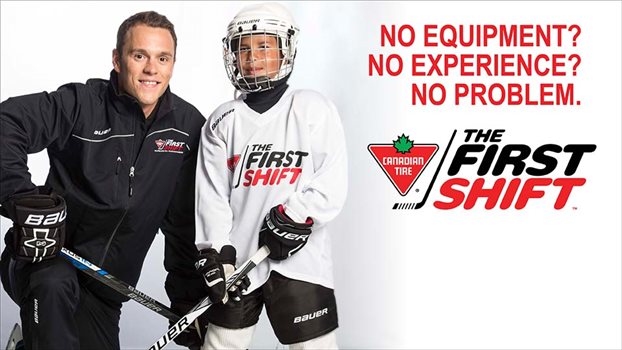
Canada’s most popular hockey-intro program returns for 2018-19 season
Registration now open for the Canadian Tire First Shift, aimed at new-to-hockey families
CALGARY, Alta. – Canada’s most popular introductory hockey program continues to expand its reach, as the Canadian Tire First Shift will be available in Inuvik, N.W.T., for the very first time.
First introduced in 2014 as a pilot project, the Canadian Tire First Shift is a learn-to-play hockey program designed for kids aged 6-10 who are new to the game. Registration for the often sold-out program begins June 1 for the 2018-19 season in communities across all 13 Hockey Canada regional members.
To-date, more than 15,500 Canadian boys and girls have been introduced to Canada’s game through the Canadian Tire First Shift, with many programs filling up on the first day of registration.
“The tremendous growth and even greater demand by kids and parents across the country has allowed Hockey Canada, and our partners Canadian Tire and Bauer, to introduce tens of thousands of Canadians to the game,” said Scott Smith, president and chief operating officer of Hockey Canada. “Many of those players move on to play within our minor hockey associations, but all of those families come away from the program with a positive experience and a new appreciation for the sport – and for Hockey Canada, that is the definition of success for this program.”
More than 190 programs have been confirmed for the 2018-19 season in provinces and territories right across the country. The response from Canadian families is no surprise to program organizers, which include Bauer Hockey, Canadian Tire, and Hockey Canada.
“As we gear up for the fifth season of the Canadian Tire First Shift, we are delighted by the overwhelming response from minor hockey associations across the country wanting to host the program, as well as a new generation of hockey players beginning their journey into our sport,” said Ludovic Lord, manager of recruitment initiatives for Hockey Canada. “Once again, the efforts and hard work of minor hockey associations and their volunteers will result in more than 6,000 children trying hockey this upcoming season as part of the Canadian Tire First Shift.”
With an emphasis on fun, the Canadian Tire First Shift allows kids ages 6-10 to easily try hockey for $199, which includes enrollment for a six-week, on-ice curriculum and head-to-toe Bauer Hockey equipment that each child can keep.
Though the program has always been open to both boys and girls, the popularity of all-female Canadian Tire First Shift programs over the last two seasons has seen more all-girl programs carved out for 2018-19 — 22, to be exact. The 2018-19 season will see 136 programs delivered as part of the Fall session, and another 56 targeted for the Winter session.
The initiative began in 2014 with four pilot programs in Ontario and Nova Scotia, expanded the following year to 35 programs, and doubled to 81 programs delivered in the 2015-16 hockey season. In each of the last two seasons, an all-time high of 150 Canadian Tire First Shift programs were delivered in communities across the country, and two-time Olympic gold-medallists Marie-Philip Poulin and Jonathan Toews joined Mark Messier as Canadian Tire First Shift ambassadors.
To learn more about the Canadian Tire First Shift in your community and how to register, please visit www.firstshift.ca. Parent information resources on hockey in Canada can be found at Hockey Canada’s Pathway to Minor Hockey.
About Bauer Hockey
Bauer Hockey is the world’s most recognized designer, marketer and manufacturer of hockey equipment. Founded in Kitchener, Ontario in 1927, Bauer Hockey developed the first skate with a blade attached to a boot, forever changing the game of hockey. Since then, Bauer Hockey has continued to develop the most sought-after products in the industry, including the widely successful SUPREME®, VAPOR® and NEXUS® lines of products.
About Hockey Canada
Hockey Canada is the governing body for hockey in Canada and a member of the International Ice Hockey Federation (IIHF), with a membership through its 13 member associations of over 700,000 players, coaches and officials. Hockey Canada is a not-for-profit organization that creates leading-edge hockey development programs for its members to deliver in communities across Canada; provides consistent rules and regulations and various other membership services from coast to coast to coast; manages numerous regional, national, and international hockey championships and events; and leads the operation of all teams that represent Canada in international ice hockey competition. Hockey Canada’s mission is to “lead, develop, and promote positive hockey experiences.” For more information on Hockey Canada, please visit HockeyCanada.ca or follow through social media on Facebook and Twitter.
About Canadian Tire
Canadian Tire Corporation, Limited, (TSX:CTC.A) (TSX:CTC) or "CTC," is a family of businesses that includes a retail segment, a financial services division and CT REIT. Our retail business is led by Canadian Tire, which was founded in 1922 and provides Canadians with products for life in Canada across its Living, Playing, Fixing, Automotive and Seasonal & Gardening divisions. PartSource and Gas+ are key parts of the Canadian Tire network. The retail segment also includes Mark's, a leading source for casual and industrial wear, and FGL Sports (Sport Chek, Hockey Experts, Sports Experts, National Sports, Intersport, Pro Hockey Life and Atmosphere), which offers the best active wear brands. The approximately 1,700 retail and gasoline outlets are supported and strengthened by our Financial Services division and the tens of thousands of people employed across the Company and its local dealers, franchisees and petroleum retailers. For more information, visit Corp.CanadianTire.ca.

Canadian Tire First Shift goes coast to coast to coast for 2017-18 season
Registration now open for popular program aimed at new-to-hockey families
CALGARY, Alta. – Canada’s most popular introductory hockey program has reached a new milestone; the Canadian Tire First Shift will be offered in communities that span all 13 of Hockey Canada’s members in the 2017-18 season.
First introduced in 2014 as a pilot project, Canadian Tire First Shift is a learn-to-play hockey program designed for kids aged 6-10 who are new to the game. More than 10,000 Canadian boys and girls have been introduced to Canada’s game through Canadian Tire First Shift, with many programs filling up on the first day of registration.
“The Canadian Tire First Shift program has taken the country by storm,” said Tom Renney, president and chief executive officer of Hockey Canada. “The evolution of this program is unprecedented as it continues to realize enrolment at an amazing pace, and an even more impressive level of excitement for this amazing hockey experience.”
More than 160 programs have been confirmed for the 2017-18 season in provinces and territories right across the country. The response from Canadian families is no surprise to program organizers, which include Bauer Hockey, Canadian Tire, and Hockey Canada.
“Since those first four pilots in the spring of 2014, the interest in the Canadian Tire First Shift has continued to grow, and it has not been an unusual occurrence for us to have to turn away interested families – in fact, it’s much more common for us to see the programs over-subscribed than under,” said Paul Carson, vice-president of membership development for Hockey Canada. “As much as Canada identifies with hockey as a symbol of our country and our citizenship, for parents who didn’t grow up playing the game – be they new Canadians or simply didn’t take part in the sport themselves growing up – Canadian Tire First Shift provides an easy way for them to let their kids try out the sport, and for them to become familiar with hockey’s fundamentals and the basics of the game and the equipment.
“We’ve found a substantive market for the Canadian Tire First Shift, and are really excited about the opportunity to reach another 5,000-plus Canadian families this season.”
With an emphasis on fun, Canadian Tire First Shift allows kids ages 6-10 to easily try hockey for $199, which includes enrollment for a six-week, on-ice curriculum and head-to-toe Bauer Hockey equipment that each child can keep.
The 2017-18 season will see 100 programs delivered as part of the Fall session, and another 60 targeted for the Winter session. Though the program has always been open to both boys and girls, the popularity of all-female Canadian Tire First Shift programs over the last two seasons has seen more all-girl programs carved out for 2017-18 – 13, to be exact.
The initiative began in 2014 with four pilot programs in Ontario and Nova Scotia, expanded the following year to 35 programs, and doubled to 81 programs delivered in the 2015-16 hockey season. Last season, an all-time high of 157 Canadian Tire First Shift programs were delivered in communities across the country, and two-time Olympic gold-medallists Marie-Philip Poulin and Jonathan Toews joined Mark Messier as Canadian Tire First Shift ambassadors.
Since its inception, an estimated 1,600 minor hockey association volunteers have supported 270 unique Canadian Tire First Shift events in the country, introducing more than 10,000 youngsters to Canada’s game.
To learn more about Canadian Tire First Shift in your community and how to register, please visit www.firstshift.ca. Parent information resources on hockey in Canada can be found at Hockey Canada’s Pathway to Minor Hockey.
About Bauer Hockey Bauer Hockey is the world’s most recognized designer, marketer and manufacturer of hockey equipment. Founded in Kitchener, Ontario in 1927, Bauer Hockey developed the first skate with a blade attached to a boot, forever changing the game of hockey. Since then, Bauer Hockey has continued to develop the most sought after products in the industry, including the widely successful SUPREME®, VAPOR® and NEXUS® lines of products.
About Hockey Canada Hockey Canada is the governing body for hockey in Canada and a member of the International Ice Hockey Federation (IIHF), with a membership through its 13 member associations of over 700,000 players, coaches and officials. Hockey Canada is a not-for-profit organization that creates leading-edge hockey development programs for its members to deliver in communities across Canada; provides consistent rules and regulations and various other membership services from coast to coast to coast; manages numerous regional, national, and international hockey championships and events; and leads the operation of all teams that represent Canada in international ice hockey competition. Hockey Canada’s mission is to “lead, develop, and promote positive hockey experiences.” For more information on Hockey Canada, please visit HockeyCanada.ca or follow through social media on Facebook and Twitter.
About Canadian Tire Canadian Tire Corporation, Limited, (TSX:CTC.A) (TSX:CTC) or "CTC," is a family of businesses that includes a retail segment, a financial services division and CT REIT. Our retail business is led by Canadian Tire, which was founded in 1922 and provides Canadians with products for life in Canada across its Living, Playing, Fixing, Automotive and Seasonal categories. PartSource and Gas+ are key parts of the Canadian Tire network. The retail segment also includes Mark's, a leading source for casual and industrial wear, and FGL Sports (Sport Chek, Hockey Experts, Sports Experts, National Sports, Intersport, Pro Hockey Life and Atmosphere), which offers the best active wear brands. The approximately 1,700 retail and gasoline outlets are supported and strengthened by our Financial Services division and the tens of thousands of people employed across the Company and its local dealers, franchisees and petroleum retailers. For more information, visit Corp.CanadianTire.ca.
For more information: |
- <
- >
















